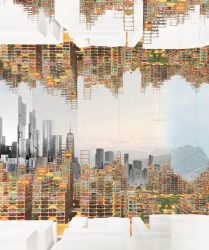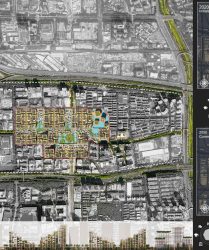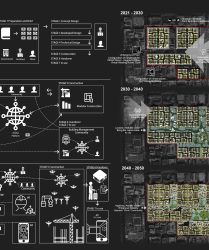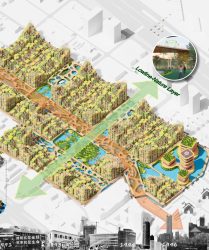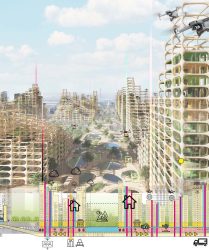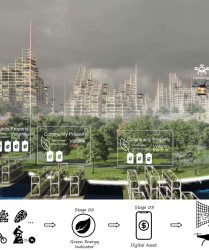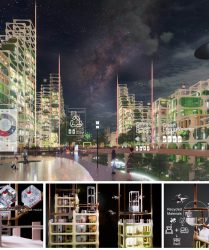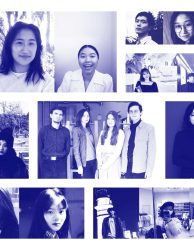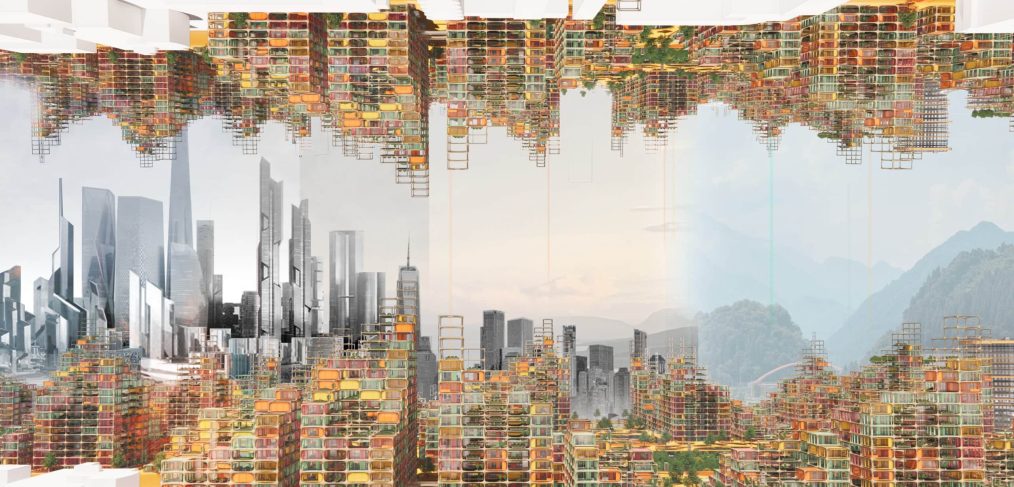
VSEFI Community
Team
Name: Dongpei Yue
Nationality: Chinese
Institution / Company: Newcastle University
Name:Zeshun Liang
Nationality:Chinese
Institution / Company: University College London
Name:Haoxin Guan
Nationality:Chinese
Institution / Company:Budapest technology and economics university
-BEST SHENZEN SITE of Community 2050 Competition | Category: Open
Introduction
VSEFI = Vertical, Sustainable, Economical, Flexible, Interactive Community
Shenzhen is an urban and young city with an identity of technology and efficiency. And our design will start with analysing the problem of density and the relationship with imbalanced city infrastructure in Shenzhen. Density in the urban city is a widespread discussion as more and more people move into the city. It brings benefits and problems such as accommodation shortage, environmental pollution, reduction of public space, etc. We try to figure out why and its solution.
Shenzhen has an interesting scenario. The city is divided into different blocks with various functions to easily achieve efficient management. For example, the factory function area will only have factories; the residential function area will only have accommodation. However, the problem is that different function areas face various situations during redevelopment within the technology and city development. And that is when the imbalanced problems begin. The government and investors will invest lots of money into those factory areas to be rebuilt quickly and efficiently. The factories can be demolished and rebuilt in a relatively short time.
On the other hand, there are many controversies about whether the people in a residential area need to be renewed, especially in the dense population area. The city redevelopment relates a vast of people benefits. And from the government perspective, time is money, the procedure of endless barraging with residents seems not a good solution. Hence, in general, the factory part of the city will be listed priority in the redevelopment procedure, which is faster than a residential area.
Therefore, the city’s density is gradually increasing because of the stagnant renewal of residential areas and the rapid growth of industrial areas. And it is followed by the uneven spatial distribution of social resources.
Vision
Our goal is to build a Vertical, Sustainable, Economical, Flexible and Interactive Community in the future. This is a balanced community for working, living and entertaining. The concept starts will ‘mountain, water and bridges’, which creates a picturesque image. The strategy brings nature to the ground that can be shared by the community instead of in a particular area that people cannot access.
Vertical
Unlike the traditional strategy of the urban landscape from the John Nash design in Regent’s Park in London, we try to merge the building, traffic, landscape and bridges in a vertical strategy to cope with density problems in an urban city. Our community keeps growing, which copes with climate change and city development. The architecture structure and each module are 3D printed with recycled materials.
Sustainable and Economical
Both landscape and architecture can gather the rainwater. The landscape and architecture create a recycled water system. The plants and vegetation in the landscape will filter the polluted water and recycle the clean water to the community.
Zero Emission Strategy
Any behavioural activities that reduce carbon emissions will be counted as accumulated “Green Energy”, a digital currency in the future community. For example, planting trees and saving water will earn the currency, which encourages environmental protection. Green energy can be converted into virtual assets to exchange services in reality.
Building construction
The growing building structure is another strategy to cope with population density. It can be designed by the government or users that depend on accommodation needs. The material we choose is living building materials (LBMS) (Luntz, 2020). It can be easily recycled and produced in the community system and 3D printing system. Ultimately, the community will be growing like a tree.
Flexible, interactive Office and Houses.
We redesigned the modular house and office and made them more flexible in delivering and constructing. Moreover, People can design the space they prefer through 3D printings. Because while the massive development of AR and VR, we could even work from home and build a strong connection with the virtual world and reality through these technologies.
Reference
Luntz, S., 2020. Concrete That Grows Could One Day Form Self-Healing Buildings, Including On Mars. [online] IFLScience. Available at: <https://www.iflscience.com/environment/concrete-that-grows-could-one-day-form-selfhealing-buildings-including-on-mars/> [Accessed 16 January 2020].
#Vertical #Economical #Flexible #Interactive #Sustainability #2050 Community

